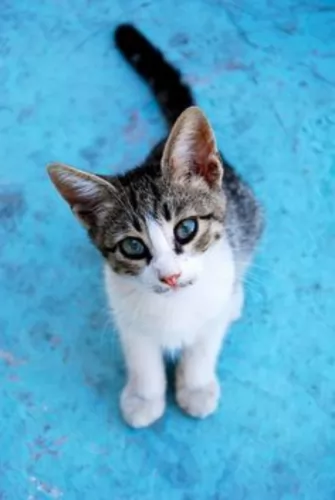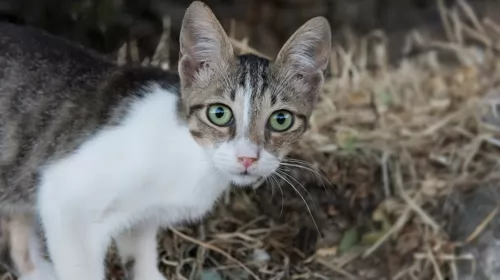 Petzlover
Petzlover Aegean is originated from Greece but Birman is originated from France. Both Aegean and Birman are having almost same weight. Both Aegean and Birman has almost same life span. Both Aegean and Birman has same litter size. Both Aegean and Birman requires Moderate Maintenance.
Aegean is originated from Greece but Birman is originated from France. Both Aegean and Birman are having almost same weight. Both Aegean and Birman has almost same life span. Both Aegean and Birman has same litter size. Both Aegean and Birman requires Moderate Maintenance.
 Thought to be the only native Greek variety of cat, the attractive Aegean cats hails from Greece – more specifically the Cycladic Islands of Greece.
Thought to be the only native Greek variety of cat, the attractive Aegean cats hails from Greece – more specifically the Cycladic Islands of Greece.
Formal breeding of the cat started in the 1990s but the cat isn’t recognized by any of the top cat breeding organizations. These cats are believed to be one of the oldest domesticated cat breeds, and in Greece are considered a national treasure.
 There isn’t clarity as to this exquisite cat’s origins. Many people believe they originated as the companions of temple priests in northern Burma.
There isn’t clarity as to this exquisite cat’s origins. Many people believe they originated as the companions of temple priests in northern Burma.
The cats somehow found their way to France, and it is believed that they have been in France since the 1920s.
The cats nearly disappeared during World War II, but luckily the remaining Birmans that survived were crossed with Siamese and Persians to strengthen the breed. In the early 1950s, pure Birnam litters were produced. It was in about 1959 that Birmans were brought to the United States.
The cats were also recognized in Britain in 1965 and in 1966 by the CFA. The first Birman cats were seal point but later other colors were brought in such as red, chocolate, and tabby.
 Aegean cats are a nice athletic, medium-sized cat with fairly longish hair and weighing in the region of 4.5 – 5 kg and standing in height at between 21 and 25,4cm.
Aegean cats are a nice athletic, medium-sized cat with fairly longish hair and weighing in the region of 4.5 – 5 kg and standing in height at between 21 and 25,4cm.
The cat sheds during the spring and summer, but if they are essentially indoor cats they will shed all year.
The coat can be made up of two or three colors with white always as one of the main colors and taking up more space on the coat than other colors. Other colors in all their different patterns can be grey, orange or black.
The tail of the cat is long and bushy the ears are quite large and wide at the base and are then gently rounded at the top. The head is broad, the eyes are almond-shaped and can be anything from green to blue or yellow.
These cats are strange in that they quite enjoy being around water, fascinated by the movements below the water’s surface. They’re also social cats, love being around their human family and also around children in the home.
If you have a hobby such as fishing you can take this breed of cat with. In fact, they love the outdoors and if you go out hiking or fishing, they’ll be there, climbing and exploring with you. These attractive cats are known to make awesome family pets, having been domesticated for centuries. Full of energy, they are also quite vocal.
 These are medium-sized cats which can become fairly large. They can weigh up to 4, 5 or 6kg. They are fairly heavily boned with a broad face and ears that are widely spaced.
These are medium-sized cats which can become fairly large. They can weigh up to 4, 5 or 6kg. They are fairly heavily boned with a broad face and ears that are widely spaced.
The round eyes are deep blue. The cat’s fur is medium-long and should be silky to the touch with no undercoat. Ther cat is a moderate shedder.
The base color is whitish to cream, but the kittens are always born white. Coat color, whether red, cream, or chocolate is always pointed and the cat always has the white paws.
The Birman isn’t as outgoing as some of the other cat breeds and its a quiet, docile intelligent cat that attaches itself to one particular family member. They can actually become jealous of their human companion and demand their attention.
These friendly cats are wonderful choices for families with children and dogs. They are calm and affectionate, and softly spoken, quietly letting you know when it’s dinner time and enjoying just being around his human family.
He is able to get along well with kids and other pets in the home. He can become quite playful too and because he is so intelligent, you can buy him some toys that require him to think.
 The Aegean is friendly, loving and social and he will get on well with children and animals in the home.
The Aegean is friendly, loving and social and he will get on well with children and animals in the home.
He is intelligent and will try to talk to you, even if it's to invite you to go swimming with him, as he is an unusual cat with his love of water.
Bringing such a cat into your home and heart will promise to bring you years of wonderful companionship.
 The Birman cat has to be one of the most beautiful cats there are, but the cat isn’t only a beautiful cat, it has wonderful characteristics as well.
The Birman cat has to be one of the most beautiful cats there are, but the cat isn’t only a beautiful cat, it has wonderful characteristics as well.
It is a loving, affectionate cat with his human family, loving to spend time around them. Playful and healthy, when you bring this most wonderful cat into your home, it will be as though an angel has come to stay.
 With good health your Birman can reach up to 13 years of age. With the Birman, the most serious illness is feline hypertrophic cardiomyopathy which also happens to be the most common heart disease in cats.
With good health your Birman can reach up to 13 years of age. With the Birman, the most serious illness is feline hypertrophic cardiomyopathy which also happens to be the most common heart disease in cats.
It’s a progressive disease and can result in heart failure. The cats are also at risk of developing feline infectious peritonitis.
Also, because this is a larger cat and a stocky kind of breed, it can easily put on weight and then become overweight. Strict attention will need to be given to diet as well as daily exercise.
Also, look out for Corneal dermoid - skin and hair on the surface of the cornea in one eye or in both. Luckily this is an eye problem that can be surgically corrected.
 Once you bring a kitten into your home, or any pet for that matter, get to know where your closest vet is. This is so you know where to go if your pet becomes ill, he requires his first vaccines or there is a medical emergency where he needs to see someone immediately.
Once you bring a kitten into your home, or any pet for that matter, get to know where your closest vet is. This is so you know where to go if your pet becomes ill, he requires his first vaccines or there is a medical emergency where he needs to see someone immediately.
When you buy food for your cat, try and buy high-quality food. Speak to your vet if you aren’t sure how to feed your cat. Cats require taurine, which is an essential amino acid needed for healthy hearts. Always make sure your cat has fresh, cool water at all times.
Every cat, whether short- or long-haired will require some combing and brushing to get rid of those loose hairs. The Aegean cat is a moderate shedder. Not only that, if you start with this grooming when your cat is a kitten, he will look forward to it and it will strengthen the bond between you.
Both fleas and ticks can be found on cats, and controlling these kinds of parasites requires speaking to your vet for something that can get rid of them. The vet will recommend products, and a flea and tick collar can also be useful but they will need to be renewed quite frequently.
Your Aegean kitten will need vaccinations to protect him from life-threatening diseases such as Feline Leukaemia Virus, Feline Infectious Enteritis and Cat flu. The first vaccines will be required at 8 weeks of age.
Sometimes it may be necessary to also have your pet vaccinated against rabies, depending on where you live. Throughout your cat’s life, to maintain his immunity, regular booster shots will be required.
 The Birman has a silky coat that sheds moderately so you want to give him a gentle brush once or twice a week to keep the coat of his soft and silky.
The Birman has a silky coat that sheds moderately so you want to give him a gentle brush once or twice a week to keep the coat of his soft and silky.
The Birman has a full topcoat, with no undercoat which means that you won’t have the coat matting or tangling.
He’ll need his nails trimmed and his teeth checked regularly. Your vet or professional groomers can do this for you and clean his teeth and check that there are no bad teeth making your pet sick.
The Birman cat has access to some great commercial cat food as there are some seriously good quality ones.
Many cat lovers choose cat foods that are AAFCO (Association of American Feed Control Officials) approved. It at least provides minimum standards for pet foods.
For your Birman you want to avoid artificial flavors and preservatives. Choose quality foods high in meat protein. As a carnivore, a cat has a huge need for meat protein. Get to know your pet food labels and choose foods with added taurine and vitamin A.